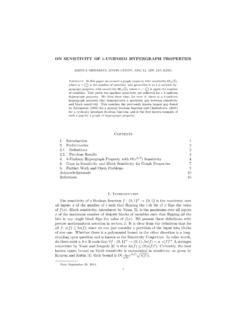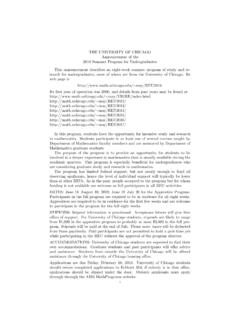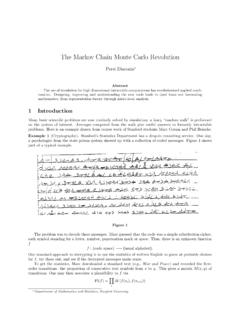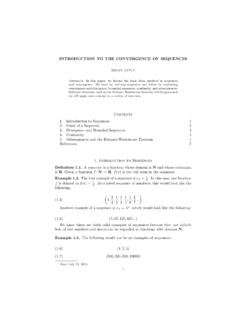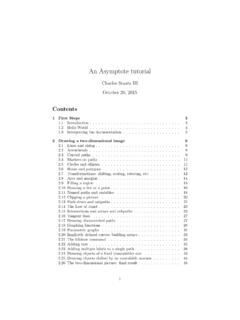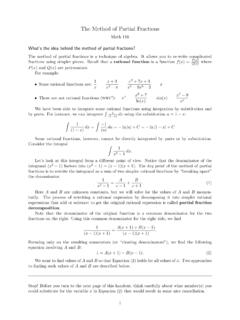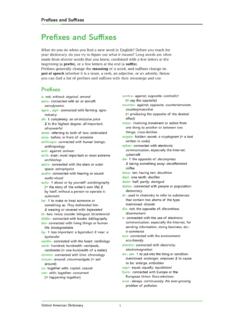Transcription of THE BOLTZMANN DISTRIBUTION
1 THE BOLTZMANN DISTRIBUTIONZHENGQU paper introduces some of the basic concepts in statisticalmechanics. It focuses how energy is distributed to different states of a physicalsystem, under certain hypothesis, it obeys the BOLTZMANN DISTRIBUTION . Iwill demonstrate three ways that the BOLTZMANN DISTRIBUTION will The Motivating Problem12. BOLTZMANN DISTRIBUTION Arises from the Principle of Indifference43. Validity of the Principle of Indifference74. BOLTZMANN DISTRIBUTION Arises as the Maximal Entropy Distribution95. Application to Particles in the Box126. Application to Gas Particles under Gravity137.
2 BOLTZMANN DISTRIBUTION Arises as the Equilibrium Motivating ProblemConsider the following game. Suppose there areNpeople and everyone hassome cash. For simplicity, each person s cash is a natural number. Now imaginethe following process. At each second we randomly uniformly pick a personA. IfAhas positive amount of cash, then we randomly uniformly pick a personB(it couldbe the same person) and transfer a dollar fromAtoB. Keep this game running fora sufficiently long period of time, will the DISTRIBUTION of wealth among this groupof people reach an equilibrium. If so, what will the equilibrium DISTRIBUTION be?
3 The answer to the above question is affirmative. LetXidenote the wealth ofthei-th person. Letudenote the average wealth so thatNuis a positive game can be modeled by a Markov chain where the state space isS={(X1,..XN) :Xi Z>0,n i=1Xi=nu}Theorem Markov chain is transitive and at any initial stateX= (X1,..,XN), it is possible to transfer allthe cash to the first person and thus reach state (Nu,0,..,0) and vice versa. ThusDate: 2017, July, WANthe Markov chain is transitive. Since it has positive probability for the stateXtoremain unchanged, the Markov chain is periodic. Theorem transition probability from any state to any of its neighboringstates is1N2.
4 Thus the stationary DISTRIBUTION of this Markov chain is the uniformdistribution each stateX= (X1,..,XN), to transition to its neighboring state(X1,..,Xi 1,..,Xj+ 1,..,XN) (assummingXi>0), we have to picki-th personfirst and then pickj-th person. Since there areNpeople in total, the probabilityis1N2. For any pair neighboring statesXandY, since we have equal transitionprobability fromXtoYand fromYtoX, the uniform DISTRIBUTION onSis sta-tionary. Since the Markov chain is irreducible and aperiodic, any initial probability distri-bution of the Markov chain will converge to the uniform DISTRIBUTION . Therefore,after the game runs for a sufficiently long period of time, we are equally likely toobserve any state describe the the DISTRIBUTION of wealth, we just have to know how many (interm of expected value) people have cashwfor eachw.
5 NoticeE[#People with wealthw] =E[N i=11{Xi=w}] =N i=1Pr[Xi=w]So we just have to know the DISTRIBUTION of eachXi. We can explicitly computePr[Xi=w]=#Ways to distribute (Nu w) wealth to (N 1)people#S=(Nu w+N 2N 2)/(Nu+N 1N 1)=(Nu w+N 2)!(N 2)!(Nu w)! (N 1)!(Nu)!(Nu+N 1)!We can use Stirling s approximation to obtain the asympototic behavior of theabove expression, but then we would trap ourselves in massive computations. In-stead, we will study the continuous analogue of this problem in the next section,which is easier to deal the amount of wealth being transferred each time is some small number 2 minstead of 1 dollar, we will obtain the uniform DISTRIBUTION on the finer grid on {(X1.)}
6 XN) :Xi 2 mZ>0,n i=1Xi=Nu}Whenmgets larger, the equilibrium DISTRIBUTION converges (weak* convergence) tothe uniform probability DISTRIBUTION on the (N 1)-dimensional simplexS={(X1,..,Xn) :Xi R>0,N i=1Xi=Nu}THE BOLTZMANN DISTRIBUTION3To obtain the probability DISTRIBUTION of individualXi, we observe that, fort [0,Nu], the region{Xi>t}is still a simplex but with size (1 tNu) times as largeasS. ThereforePr[Xi>t] =(1 tNu)N 1 Thus the density function is thus N(t) =N 1Nu(1 tNu)N 2, t [0,Nu]Sendn , we obtain =1uexp( tu), t [0,+ )This is the famousBoltzmann Distributionin statistical mechanics, which tellsus that it is less likely to find the system in higher energy states,with the prob-ability being inverse proportional to the exponential of the energy.]
7 Inthis example, the wealth is the analogue of energy in physics and we see that thenumber of people with certain wealth decreases exponentially with the important feature is that theseXiareAsymptotically Independent, joint DISTRIBUTION of the firstkvariables (X1,..,Xk) tends to be independentwhenn . Such feature is analogous to the fact in real world that, positionand momentum of different gas molecules can be regard as independent randomvariables, in spite of their collisions and prove the asymptotical independence, we first observe that, fortj>0 and jtj6Nu, the region{X1>t1,..,Xk>tk}is still a simplex but with size(1 t1+.)
8 TkNu) times as large asS. ThereforePr[X1>t1,..,Xk>tk] =(1 t1+..+tkNu)N k 1So we obtain the joint density N(t1,..,tk) = (1Nu)k(N k 1)!(N 2k 1)!(1 t1+..+tkNu)N 2k 1 SendN , we obtain (t1,..,tk) =1ukexp( t1+..+tku)Note1ukexp( t1+..+tku) =k i=11uexp( tiu)Thus we conclude asN , the individual wealthX1,..,Xktends to be inde-pendent, while each of them obeys the BOLTZMANN DISTRIBUTION Arises from the Principle of IndifferenceIn this section, we will see how BOLTZMANN DISTRIBUTION arises from the principleof indifference. We will use the ideal gas model for the ideal gas model,Nparticles move and bounce inside ad-dimensional box.
9 The particles themselves do not collide. The state of the ideal gas is completelyspecified by the positionsX1,..,XNand momentumsP1,..,PNof all the the initial state of the ideal gas is known, the system evolves according toNewtonian like in the previous game where we are interested in the DISTRIBUTION ofwealth among the people, here we are interested in the DISTRIBUTION of kinetic en-ergy among the gas particles. Although the evolution of ideal gas is deterministic,we still treatXiandPias random variables, because the number of gas particlesis huge in reality ( 1023) and it is impossible to measure the state of the systemor to solve the the positionXi and the momentumPi Rd, the state of the ideal gasbelongs to the phase space( Rd)NAt temperatureT, each particle particle has average kinetic energydkBT2(assumethe particle is mono-atomic,kBis the BOLTZMANN constant) Therefore the totalkinetic energy satisfiesN i=1P2i2m=NdkBT2 Wheremis the mass of each gas particle.
10 Therefore at temperatureT, the stateof the ideal gas belongs to the constant energy hypersurfaceS={(X,P) :N i=1P2i2m=NdkBT2}= N LWhereL={P:N i=1P2i2m=NdkBT2}It turns out, by theprinciple of indifferencein statistical mechanics, each stateon the energy hypersurface is equally likely to be observed as any other (X,P) is the uniform random variable onS. We have the followingmeaningful consequences:(1) EachXiis a uniform random variable in .(2) The positions of different particles are independent, {X1,..,XN}isindependent.(3) The positions (X1,..,Xn) are independent to the momentums (P1.)


